
hotline:
17715390137
Tel/Wechat:
18101240246 (Technology)
0512-68565571
Email:mxenes@163.com (Sales Engineer)bkxc.bonnie@gmail.com
Scan the code to follow or search the official account on WeChat:
2D Materials Fronrier After paying attention,
click on the lower right corner to contact us,
Enter enterprise WeChat.
Professional Services Online

【Introduction】
Energy and the environment play a vital role in the development of the world. With the rapid reduction of fossil fuels and the deterioration of the environment, the energy revolution is imminent. Lithium-ion batteries (LIBs), as an important energy storage device, have achieved great success after more than 30 years of development. However, the energy density of commercial LIBs with graphite anodes has reached the upper limit and cannot meet the requirements of long-distance electric vehicles. In addition, the unbalanced distribution and scarcity of lithium resources on the earth limit the wide application of LIBs in the future. In the past few years, metal anodes based on deposition/stripping electrochemistry (such as metal Li, Na, K, Zn, Mg, Ca, Al and Fe) due to their higher theoretical specific capacity and lower electrochemical potential And the higher electronic conductivity has attracted widespread attention, and the metal negative electrode can be paired with the positive electrode to construct a high-energy density rechargeable metal battery. However, inherent problems during battery cycling include large volume changes, unlimited dendritic growth, and unstable solid electrolyte interphase (SEI) hindering their further development. Among them, MXene, as an emerging two-dimensional material, has shown great potential in solving the inherent problems of metal negative electrodes due to its two-dimensional structure, abundant surface functional groups and structural capabilities. So far, with the help of MXene, researchers have proposed various strategies to achieve stable and dendritic-free metal anodes, such as MXene-based current collector design, MXene-based metal-philic matrix, and MXene to modify the metal surface to construct MXene Array and use MXene to modify the diaphragm or electrolyte. However, there is no report on the research progress of MXene in battery metal anodes.
Recently, Associate Professor Feng Jinkui of Shandong University (corresponding author) carefully summarized and analyzed the application and progress of MXene in stable and dendritic-free metal anodes. Some viewpoints and prospects for future research are also put forward. First, the author outlines the research background of metal anodes, including the types of metal anodes, electrochemical behavior, advantages, existing problems and corresponding modification strategies. Then introduced the basic information of MXene, such as type, synthesis method, advantages and applications. Finally, the application of MXene in Li-metal, Na-metal, K-metal and Zn-metal anodes is discussed. As the research on MXene and metal anodes increases year by year, I believe this review can provide some help for their further development and attract more relevant researchers to explore. Related research results were published on Adv. Funct. Mater. with the title "Recent Advances of Emerging 2D MXene for Stable and Dendrite-Free Metal Anodes".
【Picture Guide】
In the past few years, metal negative electrodes such as metals Li, Na, K, Zn, Mg, Ca, Al and Fe have been extensively studied in rechargeable metal batteries, which can be paired with positive electrodes to form advanced high Energy density lithium metal, sodium metal, potassium metal, zinc metal, magnesium metal, calcium metal, aluminum metal and iron metal batteries, all of which are derived from their higher theoretical specific capacity, lower electrochemical potential and superiority Electronic conductivity.
Figure 1. Application of MXene in metal anode

(A) Demonstrated the application of MXene in a stable and dendritic-free metal anode;
(B) Articles about the application of MXene in metal anodes;
(D) A schematic diagram showing the electrochemical behavior of the metal anode in a metal battery.
Figure 2. Preparation and principle of Ti3C2-Li composite anode
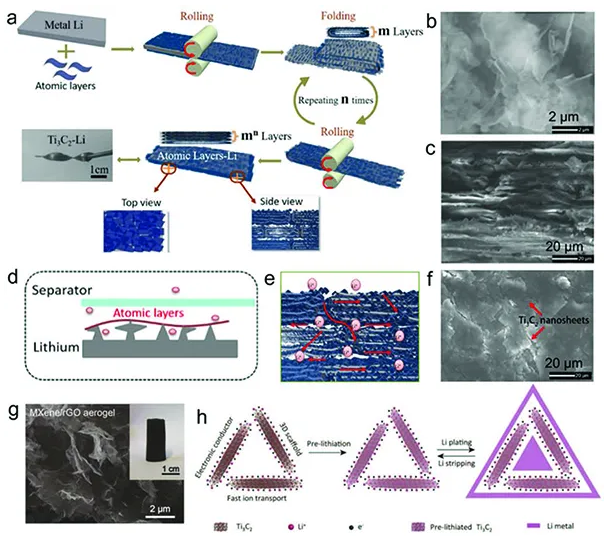
(A) shows the preparation process of Ti3C2-Li composite anode;
(B) SEM image of Ti3C2-Li composite anode;
(C) Cross-sectional SEM image of Ti3C2-Li composite negative electrode;
(D) The MXene layer can physically inhibit the vertical growth of Li dendrites;
(E) Sufficient transmission paths for electrons and Li+ in Ti3C2-Li composite anode;
(F) SEM image of Ti3C2-Li composite anode after cycling;
(G) SEM image of MXene/rGO aerogel;
(I) Schematic diagram of lithium deposition/exfoliation in MXene/rGO aerogel.
Figure 3. Preparation and principle of Li-Ti3C2Tx-rGO composite anode
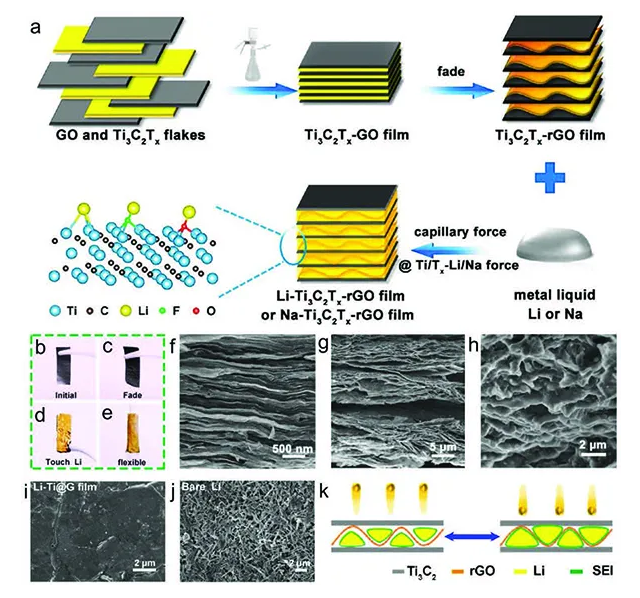
(A) The preparation process of Li-Ti3C2Tx-rGO composite anode;
(B) Optical photo of Ti3C2Tx-rGO;
(C) Optical photo of 3D porous Ti3C2Tx-rGO;
(D, e) Photos of Li-Ti3C2Tx-rGO composite anode;
(F) SEM image of Ti3C2Tx-rGO;
(G) SEM image of 3D porous Ti3C2Tx-rGO;
(H) SEM image of Li-Ti3C2Tx-rGO composite anode;
(I) SEM image of Li-Ti3C2Tx-rGO composite negative electrode after 200h cycle;
(J) SEM image of ordinary lithium foil after 200h cycle;
(K) Schematic diagram of Li deposition/stripping of Li-Ti3C2Tx-rGO composite anode.
Figure 4. Preparation of MG-Li composite anode and MXene-MF
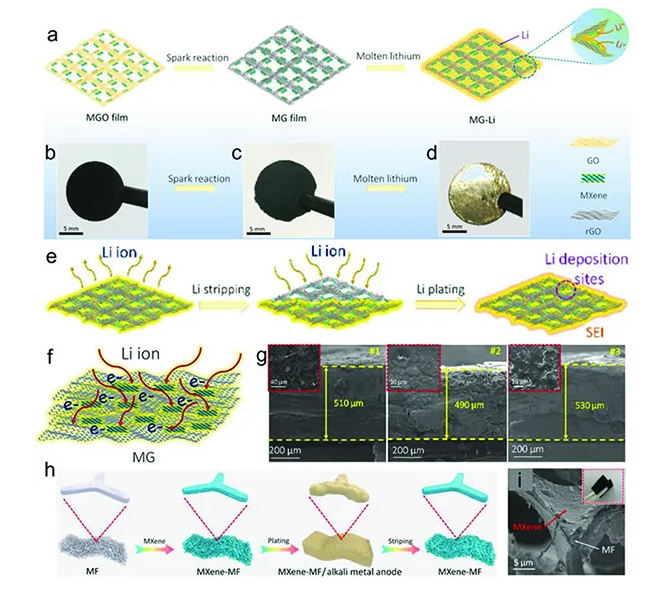
(A) Schematic diagram of the preparation process of MG-Li composite anode;
(B) Optical photograph of MGO film;
(C) Optical photograph of MG film;
(D) Photo of MG-Li composite negative electrode;
(E) A schematic diagram of the peeling/deposition process of the MG-Li composite negative electrode;
(F) A schematic diagram showing the uniform distribution of multi-dimensional ion/electron transport channels and Li+ flux/electric field;
(G) Cross-sectional SEM images of the MG-Li composite negative electrode under different cycling conditions;
(H) A schematic diagram showing the preparation process of 3D MXene-MF and the electrochemical behavior of alkali metal anode in 3D MXene-MF;
(I) SEM image of MXene-MF.
Figure 5. Preparation of flexible composite electrode

(A) Schematic diagram of the preparation process of Li-rGO/Ti3C2Tx composite anode;
(B) Cross-sectional SEM image of GO/Ti3C2Tx film;
(C) Optical photo of GO/Ti3C2Tx film;
(D) SEM image of Li-rGO/Ti3C2Tx composite anode;
(E) Optical photo of Li-rGO/Ti3C2Tx composite anode;
(F) Schematic diagram of Li deposition/stripping process on MXene@CNF;
(G, h) Optical photo of flexible MXene@CNF film;
(K,l) Cross-section and top SEM image of flexible MXene@CNF film;
(M, n) Top and cross-sectional SEM images of Li in MXene@CNF/Li after peeling off 2 mAh cm-2 of Li.
Figure 6. Preparation process of Zn-MXene and its deposition on Cu foil
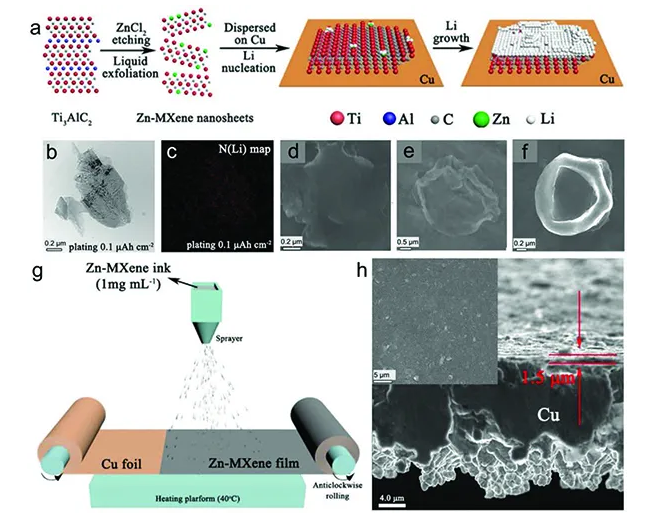
(A) Schematic diagram of the preparation process of Zn-MXene and its Li nucleation and growth behavior on Cu foil;
(B, c) STEM images and corresponding element distributions after depositing 0.1 µAh cm-2 Li on the Zn-MXene layer;
(D-f) SEM images after depositing 5, 20 and 60 µAh cm-2 of Li on the Zn-MXene layer;
(G) Large-scale preparation of Zn-MXene film;
(H) Cross-sectional SEM image of Zn-MXene film on Cu foil.
Figure 7. Preparation of flexible 2D Si@MXene electrode
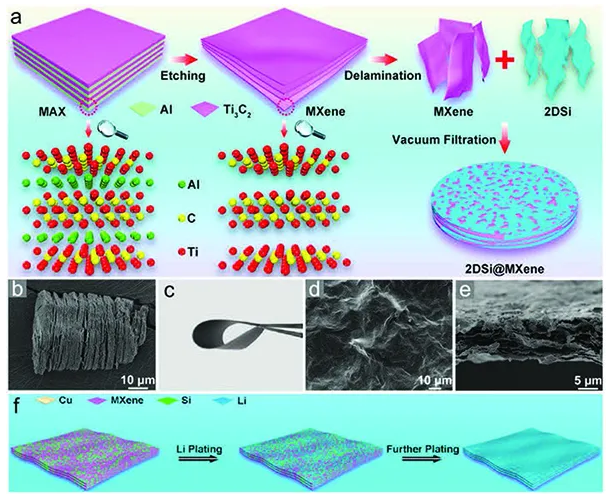
(A) Schematic diagram of the preparation process of flexible 2D Si@MXene film;
(B) SEM image of 2D Si;
(C) Optical photo of flexible 2D Si@MXene film;
(D, e) Top and cross-sectional SEM images of flexible 2D Si@MXene film;
(F) Li deposition behavior on flexible 2D Si@MXene film.
Figure 8. Preparation of MF and MLF composite electrode
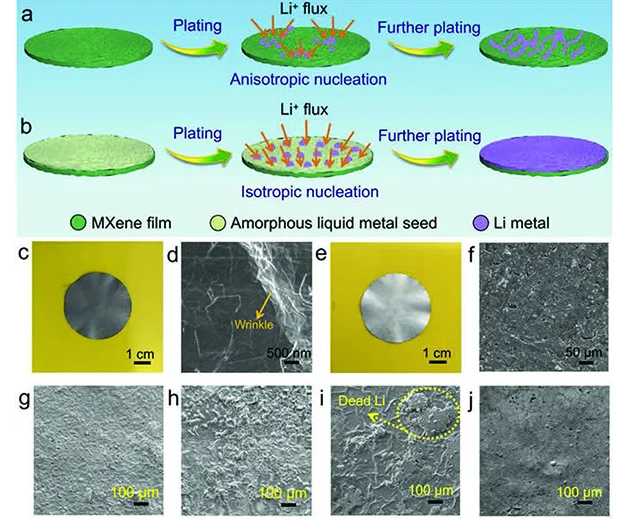
(A, b) A schematic diagram showing the deposition behavior of Li on MF and MLF respectively;
(C) Optical photograph of MF;
(D) SEM photo of MF;
(E) Optical photograph of MLF;
(F) SEM image of MLF;
(G, h) SEM image of Li deposited 0.5 mAh cm-2 on MLF and MF respectively;
(I,j) SEM images of MF and MLF after 50 deposition/stripping processes respectively.
Figure 9. Preparation of PA-MXene-Li composite electrode
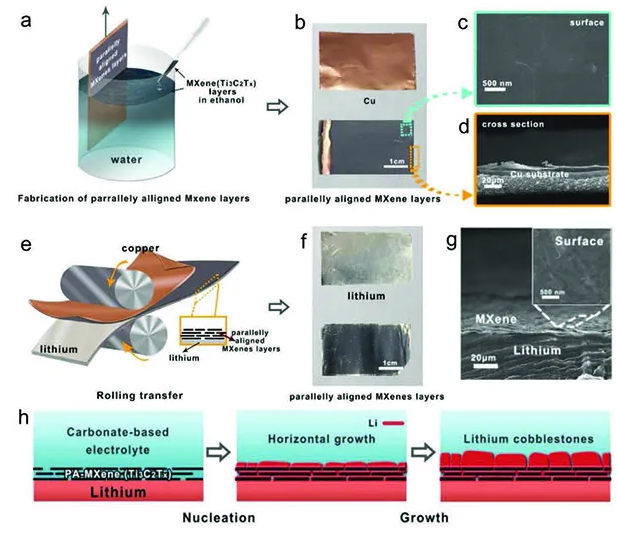
(A) Schematic diagram of the preparation process of PA-MXene-Cu;
(B) Optical photos of Cu foil and PA-MXene-Cu;
(C, d) Top and cross-sectional SEM images of PA-MXene-Cu;
(E) The transfer process of MXene film from PA-MXene-Cu to the surface of Li foil;
(F) Optical photos of Li foil and PA-MXene-Li;
(G) PA-MXene-Li cross-sectional SEM image;
(H) Schematic diagram of the deposition behavior of Li on PA-MXene-Li.
Figure 10. Preparation of ILC-Li electrode
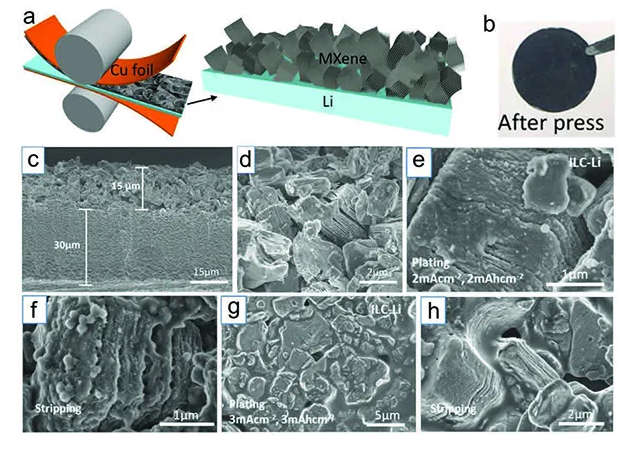
(A) A schematic diagram showing the manufacturing process of ILC-Li using stainless steel drums;
(B) An optical photo of ILC-Li;
(C) Cross-sectional SEM image of ILC-Li;
(D) The enlarged cross-sectional SEM image of ILC-Li;
(E, f) SEM image of ILC-Li electrode when Li is deposited and stripped at 2 mAh cm-2;
(G, h) SEM image of ILC-Li electrode when Li is deposited and peeled off at 3 mAh cm-2.
Figure 11. Preparation of laser-treated MXene film
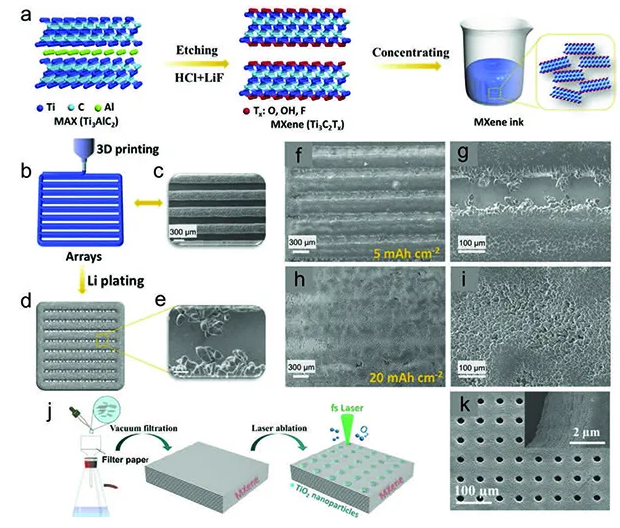
(A, b) A schematic diagram showing the manufacturing process of the MXene array using extrusion 3D printing technology;
(C) SEM image of MXene array;
(D) Schematic diagram of Li nucleation and growth on the MXene array;
(E) Li nucleation and growth on MXene array;
(F, g) SEM image of 5 mAh cm-2 Li deposited on the MXene array;
(H, i) SEM image after depositing 20 mAh cm-2 Li on the MXene array;
(J) Schematic diagram of the manufacturing process of laser processing MXene film;
(K) SEM image of laser processed MXene film.
Figure 12. Deposition behavior of Li on MXene-Li composite electrode
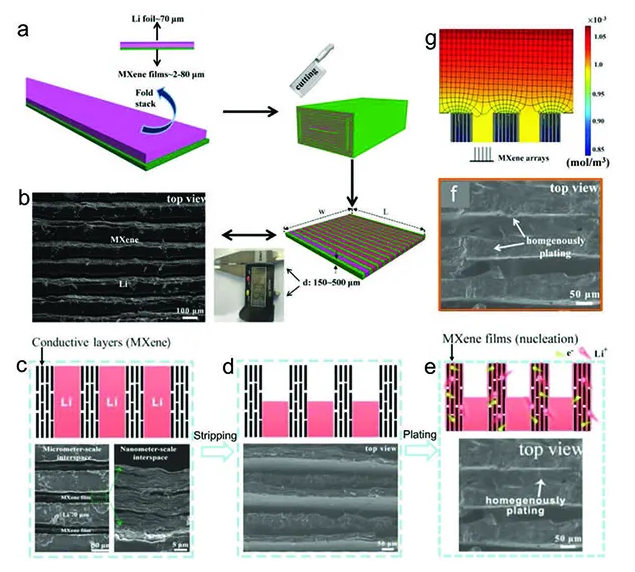
(A) A schematic diagram of the preparation process of the vertical MXene-Li array;
(B) SEM image of vertical MXene-Li array;
(C-e) SEM images show the deposition/exfoliation behavior of Li on the vertical MXene-Li array;
(F) SEM image after depositing 1 mAh cm-2Li on the vertical MXene-Li array;
(G) During the deposition process, the COMSOL multiphysics simulated the Li concentration distribution in the vertical MXene-Li array.
Figure 13. Membrane modification inhibits dendrite growth
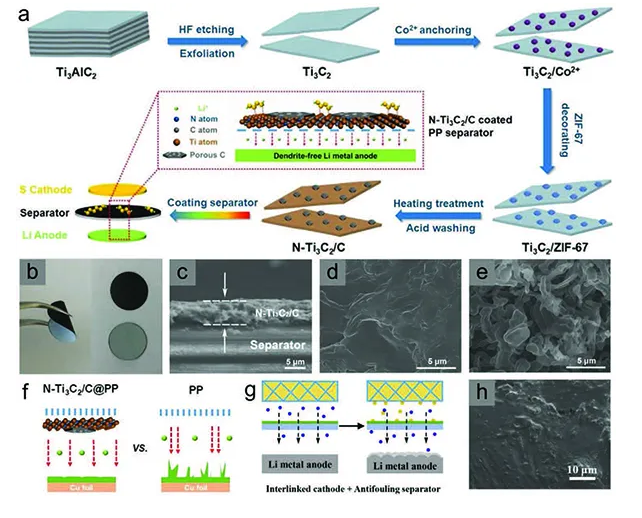
(A) Preparation process of N-Ti3C2/C@PP diaphragm;
(B) Optical photo of N-Ti3C2/C@PP membrane;
(C) Cross-sectional SEM image of N-Ti3C2/C@PP diaphragm;
(D) SEM image of 1 mAh cm-2 deposited in Li|Cu battery using N-Ti3C2/C@PP diaphragm;
(E) SEM image after depositing 1 mAh cm-2 in Li|Cu battery using PP separator;
(F) Using N-Ti3C2/C@PP and PP separator to study the deposition behavior of Li|Cu battery on Cu foil;
(G) Schematic diagram of Li deposition behavior in Li-S battery using T@CP modified separator;
(H) SEM image of Li negative electrode after 100 cycles of T@CP modified separator in Li-S battery.
Figure 14. Preparation process of MCPEs
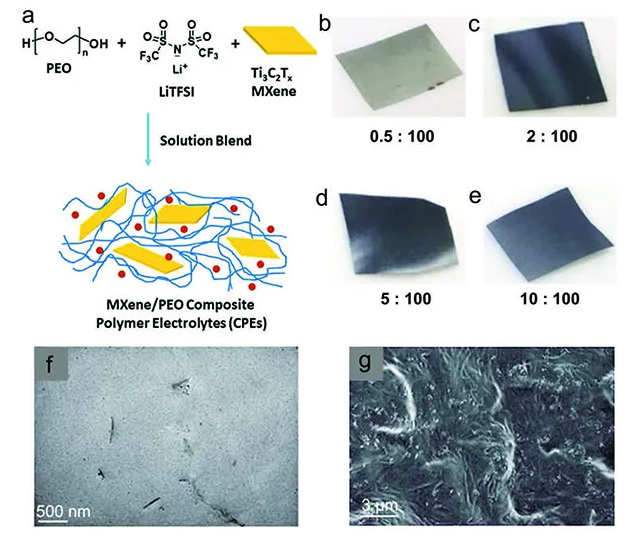
(A) Schematic diagram of the preparation process of MCPEs;
(B-e) MCPEs with different mass ratios of MXene and PEO;
(F) TEM image of MCPE cross section (the mass ratio of MXene to PEO is 0.02);
(G) Cross-sectional SEM image of MCPE (the mass ratio of MXene to PEO is 0.05).
Figure 15. Schematic diagram of the preparation process of CT-Sn(II)@Ti3C2
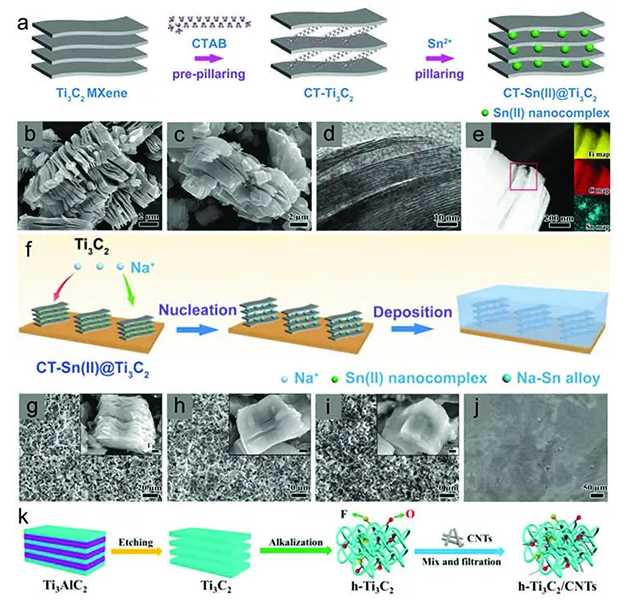
(A) A schematic diagram of the preparation process of CT-Sn(II)@Ti3C2;
(B) SEM image of Ti3C2;
(C) SEM image of CT-Sn(II)@Ti3C2;
(D) CT-Sn(II)@Ti3C2 high-magnification TEM image;
(E) CT-Sn(II)@Ti3C2 STEM image and corresponding element mapping;
(F) Na nucleation and deposition behavior in CT-Sn(II)@Ti3C2 current collector;
(G-j) SEM images of 0, 0.5, 1, and 5 mAh cm-2 deposited on the CT-Sn(II)@Ti3C2 current collector respectively;
(K) Schematic diagram of the preparation process of h-Ti3C2/CNTs current collector.
Figure 16. Preparation of K@DN-MXene/CNT composite anode
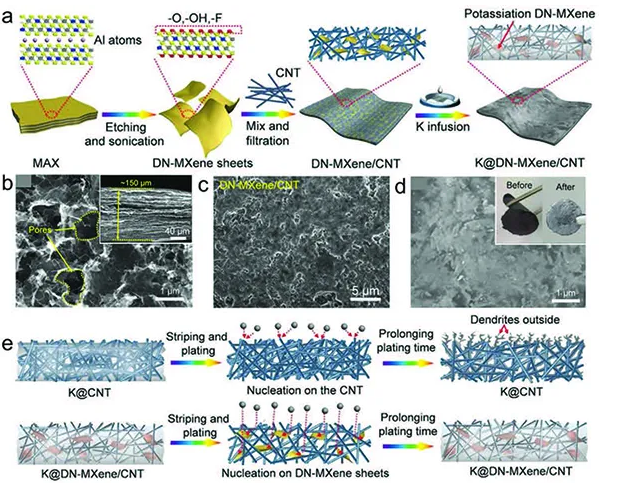
(A) Schematic diagram of the preparation process of K@DN-MXene/CNT composite anode;
(B) SEM image of DN-MXene/CNT current collector;
(C) SEM image after depositing 5 mAh cm-2K on the DN-MXene/CNT collector;
(D) SEM image of K@DN-MXene/CNT composite anode;
(E) Schematic diagram of K deposition/exfoliation behavior on CNT and DN-MXene/CNT current collectors.
Figure 17. Preparation of Ti3C2Tx MXene@Zn composite anode
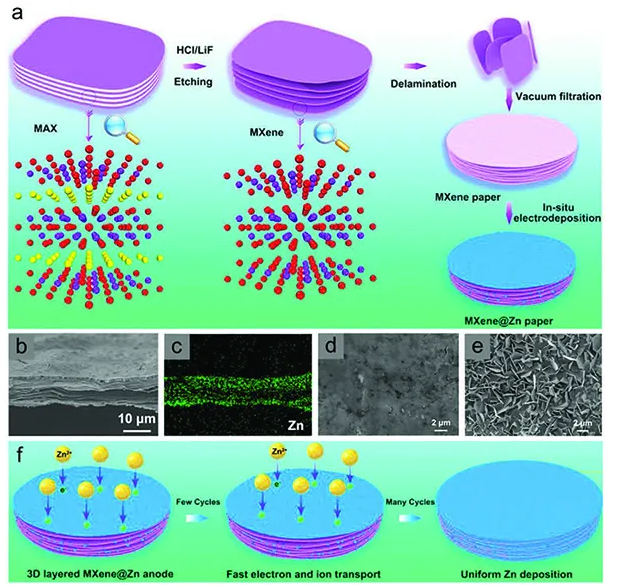
(A) Manufacturing process of flexible self-supporting Ti3C2Tx MXene@Zn composite anode;
(B, c) Cross-sectional SEM image of MXene@Zn film and corresponding Zn element mapping;
(D) SEM image of MXene@Zn film after cycling;
(E
) SEM image of zinc anode after cycling;
(F) Schematic diagram of the electrochemical behavior of MXene@Zn thin film composite anode.
Figure 18. The future direction of MXene in metal anode
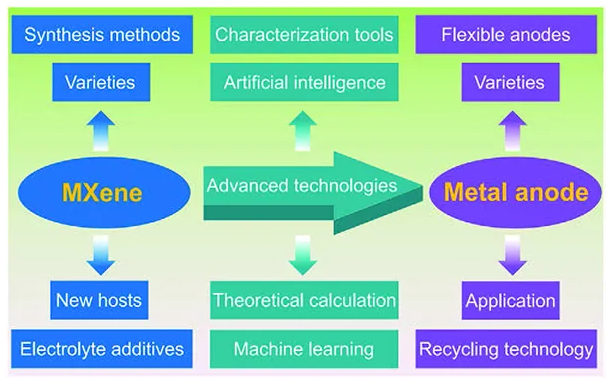
【Summary】
In summary, the author summarized the latest developments in the use of two-dimensional MXene for stable and dendritic-free metal anodes, and also put forward some opinions and prospects. Studies have shown that the application of MXene in metal anodes is increasing year by year. As an emerging multifunctional 2D material, MXene can solve the inherent lithium dendrite problem of metal anodes. However, the research and application of MXene in metal anodes is still in progress. In the initial stage, more and more in-depth research should be done in the future. Recently, the emerging 2D MXene and metal anodes have become research hotspots. With the rapid development of two-dimensional MXene and metal anodes, it is certain that more and more MXene will be used in the modification of metal anodes in the future. Therefore, this review can attract relevant researchers and provide some guidance for future research.
Literature link: "Recent Advances of Emerging 2D MXene for Stable and Dendrite-Free Metal Anodes" (Adv. Funct. Mater., 2020, 10.1002/adfm.202004613)
This article is contributed by CYM.
Information source: material person
This information is from the Internet for academic exchanges. If there is any infringement, please contact us and delete it immediately

| Reminder: Beijing Beike New Material Technology Co., Ltd. supplies products only for scientific research, not for humans |
| All rights reserved © 2019 beijing beike new material Technology Co., Ltd 京ICP备16054715-2号 |